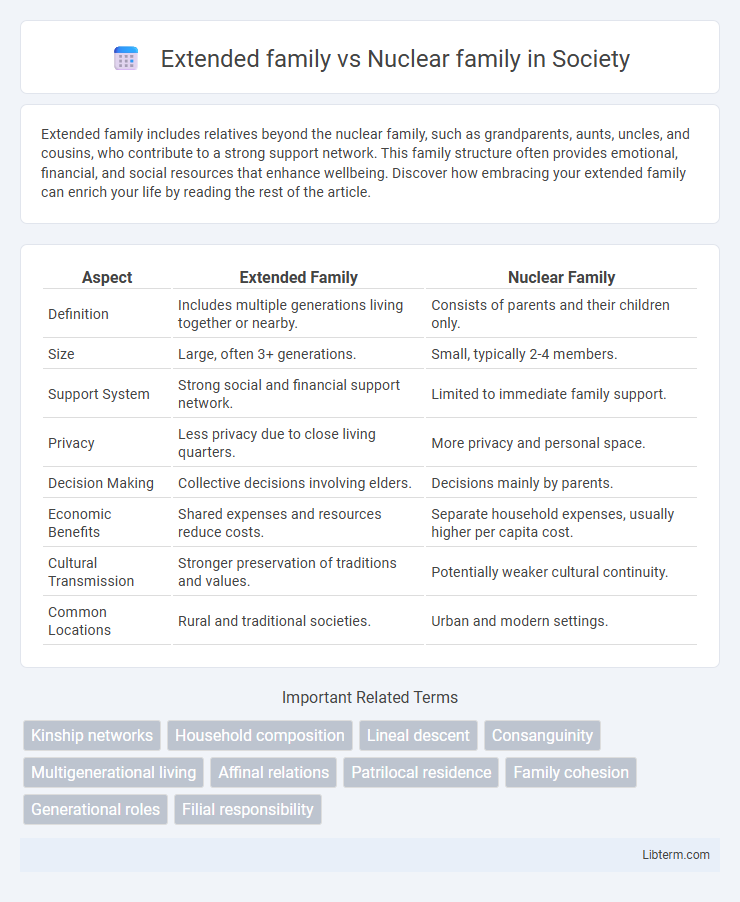Extended family includes relatives beyond the nuclear family, such as grandparents, aunts, uncles, and cousins, who contribute to a strong support network. This family structure often provides emotional, financial, and social resources that enhance wellbeing. Discover how embracing your extended family can enrich your life by reading the rest of the article.
Table of Comparison
| Aspect | Extended Family | Nuclear Family |
|---|---|---|
| Definition | Includes multiple generations living together or nearby. | Consists of parents and their children only. |
| Size | Large, often 3+ generations. | Small, typically 2-4 members. |
| Support System | Strong social and financial support network. | Limited to immediate family support. |
| Privacy | Less privacy due to close living quarters. | More privacy and personal space. |
| Decision Making | Collective decisions involving elders. | Decisions mainly by parents. |
| Economic Benefits | Shared expenses and resources reduce costs. | Separate household expenses, usually higher per capita cost. |
| Cultural Transmission | Stronger preservation of traditions and values. | Potentially weaker cultural continuity. |
| Common Locations | Rural and traditional societies. | Urban and modern settings. |
Definition of Nuclear Family
A nuclear family consists of two parents and their children living together as a single household unit, emphasizing a more immediate familial structure. This family model contrasts with the extended family, which includes additional relatives such as grandparents, aunts, uncles, and cousins residing either together or nearby. The nuclear family is often associated with modern societal frameworks where independence and mobility are prioritized.
Definition of Extended Family
An extended family consists of multiple generations living together or maintaining close relationships, including grandparents, aunts, uncles, cousins, and parents with their children. This family structure emphasizes collective support, shared resources, and cultural continuity beyond the immediate parental unit found in nuclear families. Extended families are prevalent in many traditional societies and play a critical role in social stability and caregiving.
Historical Evolution of Family Structures
The historical evolution of family structures reveals a shift from extended families, which traditionally included multiple generations living under one roof and sharing resources, to nuclear families consisting of two parents and their children. Industrialization and urbanization in the 19th and 20th centuries accelerated this transition by promoting economic independence and geographic mobility, reducing reliance on large kinship networks. Contemporary demographic studies show a resurgence of extended family arrangements in multicultural and economically diverse societies, reflecting adaptive responses to social and economic changes.
Cultural Perspectives on Family Types
Extended families, often prevalent in collectivist cultures such as those in Asia, Africa, and Latin America, emphasize intergenerational support and communal living arrangements. Nuclear families, common in Western societies, prioritize individualism and autonomy, typically consisting of parents and their children residing independently. Cultural values shape family structures by influencing roles, responsibilities, and social expectations within these family types.
Advantages of Nuclear Families
Nuclear families offer greater privacy and autonomy, enabling members to make decisions quickly and independently without external interference. Smaller family units typically result in stronger emotional bonds and more focused parental attention, which contributes to improved child development and well-being. Financial responsibilities are often more manageable in nuclear families, allowing for streamlined budgeting and resource allocation.
Advantages of Extended Families
Extended families offer enhanced emotional support and shared responsibilities, fostering stronger familial bonds across multiple generations. They provide economic benefits through pooled resources and collaborative childcare, easing financial burdens on individual members. This structure also preserves cultural traditions and promotes intergenerational learning, enriching the social and cognitive development of younger members.
Challenges in Nuclear Family Settings
Nuclear family settings often face challenges such as limited emotional support and increased financial pressure due to fewer family members sharing responsibilities. Isolation from extended relatives can lead to reduced social interaction and support networks, impacting mental well-being. Balancing work-life commitments and child-rearing tasks within a small family unit intensifies stress and resource constraints.
Challenges in Extended Family Arrangements
Extended family arrangements often face challenges such as complex decision-making processes due to multiple generations living together and differing values or lifestyle preferences. Conflicts may arise from resource allocation, privacy issues, and the need to balance individual autonomy with collective responsibilities. These dynamics can lead to stress and the requirement for effective communication and conflict resolution strategies to maintain harmony.
Impact on Child Development
Extended families provide children with diverse role models and a broader support network, enhancing social skills and emotional resilience. Nuclear families often offer more focused parental attention, which can promote individualized nurturing and concentrated educational support. The balance between extended and nuclear family dynamics significantly influences a child's social development, emotional well-being, and adaptability.
Modern Trends in Family Dynamics
Modern trends in family dynamics reveal a shift from extended family living arrangements, which include multiple generations residing together, towards nuclear families centered around parents and their children. Urbanization, increased mobility, and economic factors contribute to the preference for smaller family units, impacting social support systems and caregiving roles. Technology and changing cultural values also influence communication and interaction patterns within both extended and nuclear family structures.
Extended family Infographic

 libterm.com
libterm.com